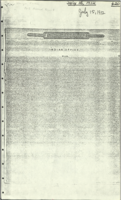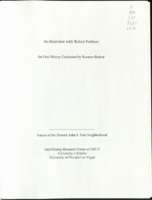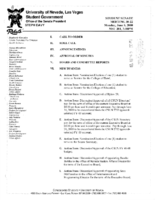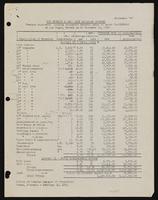Search the Special Collections and Archives Portal
Search Results

Moapa River Indian School Annual Report, 1912
Date
Archival Collection
Description
Department of the Interior, United States Indian Service 1912 annual report of the conditions on the Moapa River Reservation School. Section I includes reservation law and order. Section II includes reservation health.
Text
"Samantha Stupak the Dog" news segment: video
Date
Archival Collection
Description
Dr. David Tack with "Samantha Stupak" the dog talking about a dangerous disease called "wobble" syndrome. Original media VHS, color, aspect ratio 4 x 3, frame size 720 x 486. From the Bob Stupak Professional Papers (MS-01016) -- Professional papers -- Audiovisual material -- Digitized audiovisual clips file.
Moving Image
"Samantha Stupak the Dog" news segment: video
Date
Archival Collection
Description
Dr. David Tack with "Samantha Stupak" the dog talking about a dangerous disease called "wobble" syndrome. Original media VHS, color, aspect ratio 4 x 3, frame size 720 x 486. From the Bob Stupak Professional Papers (MS-01016) -- Professional papers -- Audiovisual material -- Digitized audiovisual clips file.
Moving Image
Campbell Family Photograph Collection
Identifier
Abstract
The Campbell Family Photograph Collection is comprised of nine black-and-white photographic reprints of Pioche, Nevada and two photographic reprints of Dr. Linwood Campbell, taken from approximately 1895 to 1929 and reprinted between approximately 1950 and 1969.
Archival Collection
Nevada State Board of Education Questions for the Examination of Teachers
Identifier
Abstract
Nevada State Board of Education Questions for the Examination of Teachers (1894) consists of a single test booklet from the Nevada State Board of Education containing questions to test the knowledge of teachers. The test includes questions from subjects such as physiology, reading, orthography, geography, and United States history.
Archival Collection

Transcript of interview with Robert "Bob"Agonia by Marcela Rodriguez-Campo, September 6, 2018
Date
Archival Collection
Description
Robert “Bob” Agonia (1938- ) was born in Garden Grove, California on a migrant camp made up of Filipino and Mexican-American workers. Agonia’s father was a farmer on a 70 acre farm owned by the Beggs family. Agonia did not spend much time living on the migrant camp, as his father moved the family to a private residence when Agonia was four. Agonia attended school, during an era of school desegregation in Garden Grove. He recalls that his mother dealt with segregation during her schooling, being forced to attend a school miles down the road from her home despite living across the street from another school. Agonia recalls his community being very diverse with families sharing Filipino and Mexican-American heritage and his neighbors being Japanese Americans. Agonia participated in a multicultural Boy Scout troop. After high school, Agonia joined the Peace Corps and served in El Salvador. While there, Agonia worked in an agricultural research center in Santa Tecla where he helped local farmers select the proper insecticide for their crops. After the Peace Corps, Agonia had his choice of government jobs, ultimately selecting to work for the Internal Revenue Service. Agonia’s work with the IRS is what eventually brought him from California to Las Vegas. He quickly realized that the type of IRS cases he would be handling in Las Vegas were completely different from the work he was accustomed to in California. One of those unique cases required him to close the doors of a downtown casino. Since moving to Las Vegas, Agonia was critical in establishing a Las Vegas LULAC chapter, an American GI Forum, an EEO council, and the UNLV Engineering school.
Text

Meeting minutes for Consolidated Student Senate, University of Nevada, Las Vegas, March 15, 2004
Date
Archival Collection
Description
Text

Transcript of interview with Robert Forbuss by Suzanne Becker, February 12, 2009
Date
Archival Collection
Description
In 1944, Robert Forbuss' mother bought a home in a new tract development called Huntridge, adjacent to the John S. Park Neighborhood. She was a single woman who had managed to put together the down payment from her earnings as a cocktail waitress. A couple years later John S. Park Elementary School was built nearby. Through any ups and downs, Marjorie Forbuss refused to live anywhere else for the rest of life, even when Robert encouraged her to move. For this interview, Robert intersperse Las Vegas history while sharing childhood memories of the neighborhood. He graduated from Bishop Gorman High School, the private Catholic prep school, in the mid-1960s. A few years later, Robert returned there as a teacher from 1973 - 1981, teaching kids with familiar last names in the neighborhood he had grown up in. During that time he lived in the John S. Park Neighborhood. He details the charm of the neighborhood, cruising the Downtown area, shopping on Fremont Street and much more. When Robert left teaching, he became the general manger of Mercy Ambulance and Medical Supply, which he ultimately owned until about 2003. During this time, he was a successful business leader and an active community member.
Text

Meeting minutes for Consolidated Student Senate, University of Nevada, Las Vegas, June 05, 2000
Date
Archival Collection
Description
Text

